I’ll let the following youtube video speak for itself.
http://www.youtube.com/watch?v=g3MWzJaRXXU&feature=player_embedded
I’ll let the following youtube video speak for itself.
http://www.youtube.com/watch?v=g3MWzJaRXXU&feature=player_embedded
Posted in Museum Stuff
The Conservation Department of the AMS program at Algonquin College continues to benefit from the support of conservators and collections staff located throughout Canada’s national capital region.
The AMS staff and students would like to thank the following guest lecturer’s for contributing to the delivery of conservation and collections care subject matter over the past academic year.
Sonya Dumais, Mike Steinhauer, Julie Hodgson, Jean-Francois Castonguay and Susan Ashley from the National Gallery of Canada for providing presentations and a round table discussion on the care, transportation and exhibition of works of art. This one day event also included ‘behind the scenes” tours of storage facilities, exhibit and transportation prep shops and conservation labs at the NGC.
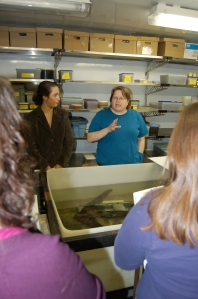 Genny Tremblay, Barbara Tose and Michael Eisen from Parks Canada – Ontario Service Center for their outstanding presentations on the storage and care of archaeological collections presented in-situ at Parks Canada facilities on Walkley Road.
Genny Tremblay, Barbara Tose and Michael Eisen from Parks Canada – Ontario Service Center for their outstanding presentations on the storage and care of archaeological collections presented in-situ at Parks Canada facilities on Walkley Road.
Marcie Kwindt, Laura Smyke-Passmore and Canadian Museum of Nature staff for their presentations on the care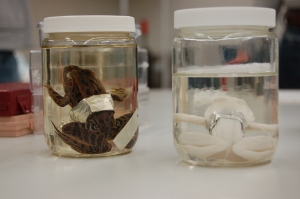 and conservation of natural history collections hosted at the CMN Pink road facilities. Presentations focused on the care of osseous, paleological, herbarium, entomological and wet marine specimen conservation.
and conservation of natural history collections hosted at the CMN Pink road facilities. Presentations focused on the care of osseous, paleological, herbarium, entomological and wet marine specimen conservation.
Rebecca Bunch and Megan Gruchy from the Canadian Museum of Civilization for their presentation on the 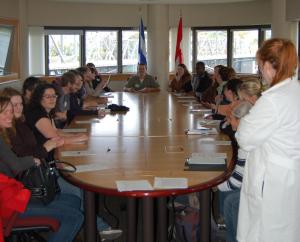 integration of conservation into the exhibition process. These presentations were also supported with tours of the exhibition galleries and conservation labs.
integration of conservation into the exhibition process. These presentations were also supported with tours of the exhibition galleries and conservation labs.
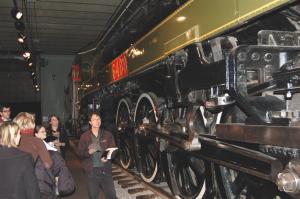
Tony Missio from the Canada Science and Technology Museum for providing insights into the conservation of industrial and scientific collections. Tony’s presentation included a tour of the exhibition areas and a presentation focusing on the unique circumstances and hazards surrounding the display and conservation of industrial collections. This lecture also included a tour of the conservation labs and storage facilities.
The third year students participated in the annual assessment of built heritage and closing of a seasonal museum at the Cumberland Heritage Village Museum. Students conducted an 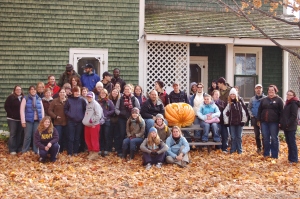 assessment of a historic building, developed maintenance plans and participated in the cleaning and closing procedures for several buildings. Thanks once again to Glenn Charron, curator of collections, for providing this unique learning opportunity.
assessment of a historic building, developed maintenance plans and participated in the cleaning and closing procedures for several buildings. Thanks once again to Glenn Charron, curator of collections, for providing this unique learning opportunity.
The AMS program continues to partner with the Ottawa Art Gallery to fabricate storage mounts for Group of Seven Works from the Firestone Collection. 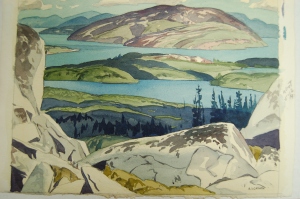 Each student assesses the work and fabricates a mount for both storage and display. A very sincere thank you to Jennifer Gilliland, OAG’s collections manager for providing this remarkable opportunity for students of the AMS program.
Each student assesses the work and fabricates a mount for both storage and display. A very sincere thank you to Jennifer Gilliland, OAG’s collections manager for providing this remarkable opportunity for students of the AMS program.
Second year students undertook condition reporting and treatment of the silver collections from Laurier House National Historic Site. A sincere thank you to Bernie Roache for this opportunity. The same group of students also completed the treatment of 43 ferrous objects from the Cumberland Heritage Village Museum.
A number of special project partnerships have taken place this year and they include;
The cleaning and mounting of one World War I flag flown by the Number 2 Canadian Stationary Hospital located in LeTouquet, France, in 1914. These treatments are being undertaken by students Michelle Hunter and Meredith Thompson for the Prince Edward Island Regiment Museum.
“This Union Jack was loaned to the government of Prince Edward Island by Major James S. Walker in 1935. Major Walker was the Captain and Quarter-Master of the Number 2 Canadian Stationary Hospital located in Le Touquet, France during the WWI. The flag was then donated to the Prince Edward Island Regiment Museum by Mr. Clarence Walker of Charlottetown, Son of Major James S. Walker.
The Number 2 Canadian Stationary Hospital was the first Canadian military force to cross the English Channel to France. It was opened in the LeTourquet hotel on November 27, 1914. The hospital housed 420 beds and an interesting distinction was the unit had named each of the hospital’s wards after Canada’s provinces. (Freeman and Nielson, 1999).
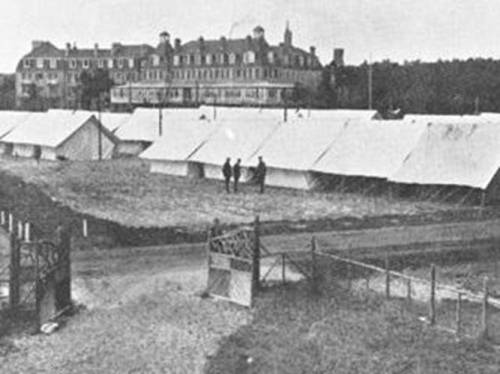
No. 2 Stationary Field Hospital in LeTourquet, France 1914 (http://nfb.ca/)
Before WWI Canada was still very much a British Colony and was at war by declaration of Britain. WWI marked the transition of Canada’s armed forces from a militia of questionable value to what was probably the most powerful army corps on either side of the conflict.” (Library and Archives 2009) Canada contributed over 600,000 troops to aid Britain, while also providing vital manufacturing facilities and assisting in the training of military personnel from around the globe. (Freeman and Nielson, 1999).”
This flag represents Canada’s influence as a political and military player during WWI. The treatment and preservation of this piece of cultural patrimony will assist in the interpretation and understanding of Canada’s role during this turbulent time.
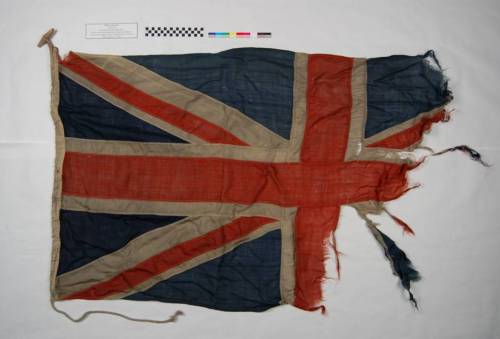
Flag Pre-Treatment September 2008
AMS Conservation Department
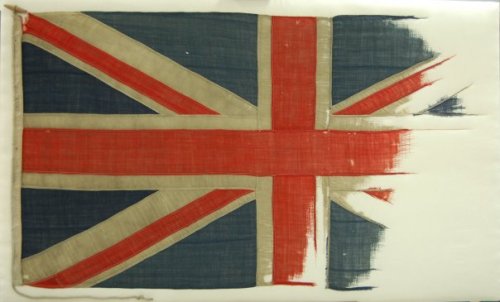
Flag Pre-Treatment April 2009
AMS Conservation Department
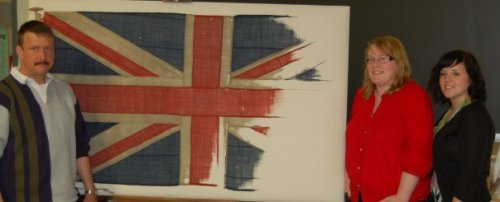
Greg Gallant, Curator P.E.I.Regiment Museum, Meredith Thompson and Michele Hunter
Conservation Students who undertook the treatment of the Flag.
AMS student Julia Loan devised a treatment process to ensure the safe removal of polyethylene sheeting that has fused to the surface to two contemporary paintings from the Ottawa Art Gallery and designed and constructed a custom crate for it’s transportation and storage.
Three AMS students, Maggie Case, Julia Nonkes and Erika Kastner have conducted collection condition surveys for three of the City of Ottawa’s institutions and developed a Cultural Health Index for the City of Ottawa’s Heritage Development Unit.
Kelly Sceviour is working in partnership with the Provincial Archaeological Office of Newfoundland and the Provincial Museum – The Rooms to develop a Conservation Policy addressing the acquisition and storage of Archaeological Iron.
Third year AMS students Catherine Boyd and Melissa Watcher participated in Site Assessments and the development of Emergency Preparedness Procedures for the City of Ottawa’s Heritage Development Unit.
Steven Greyeyes, working under the guidance of staff from Parks Canada – Ontario Service Center has undertaken the creation of a reproduction of the MacAdam Shovel – a World War I shovel used for a short period by Canadian forces.
Erica Morgan and Laurie Snider completed a risk assessment and the creation of an Emergency Preparedness Plan for Watson’s Mill.
Posted in Conservation, Museum Studies